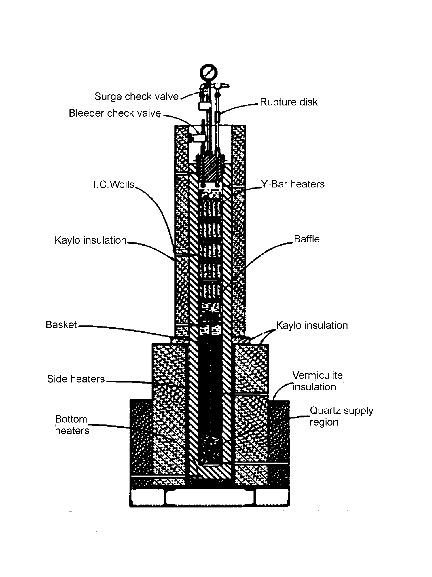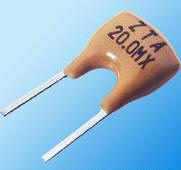|

Small chips of pure but un-faced quartz (1 to 1.5 inch in size), called
"lascas or nutrient", are placed in a wire mesh basket and lowered
into the bottom half of the vessel. A steel plate with prearranged holes, called
a "baffle", is set on top of the basket. The baffle is used to
separate the growth (seed) region and the nutrient region, and to help establish
a temperature differential between the two regions. Suitably oriented single
crystal plates (either natural or cultured), called "seed", are
mounted on a rack and suspended on top of the baffle in the upper half of the
vessel. The autoclave is then filled with an aqueous alkaline solution (Sodium
Carbonate or Sodium Hydroxide) to approximately 80% of its free volume to allow
for future liquid expansion, and it is sealed with a high-pressure closure. The
autoclave is then brought to operating temperature by a series of resistive
heaters attached to the exterior circumference of the cylinder. As the
temperature increases, the pressure begins to build within the autoclave. A
temperature of 700 to 800° F is attained in the
lower half of the vessel while the top half is maintained at 70 to 80°
F cooler than the bottom half.
At operating pressure and temperature, the lascas dissolves in the heated
solution in the lower half of the vessel, which then rises. As it reaches the
cooler temperature of the upper part of the vessel, the solution becomes
supersaturated, causing the dissolved quartz within the lascas to re-crystallize
onto the seed. The cooled spent solution then returns to the lower half of the
vessel to repeat the cycle until the lascas is depleted and the cultured quartz
stones have reached the desired size. This so-called "Hydrothermal
Process" time ranges from 25 to 365 days, depending upon the desired stone
size, properties, and the process type – Sodium Hydroxide or Sodium Carbonate.
3. Symmetry, Twinning and Size of Quartz Crystal
Alpha-quartz belongs to the crystallographic class 32, and it
is a hexagonal prism with six cap faces at each end. The prism faces are
designated m-faces and the cap faces are designated R and r-faces. The R-faces
are often called major rhomb faces and the r-faces are minor rhomb faces.
Both left-hand and right-hand crystals occur naturally and can be distinguished
by the position of the S and X faces.
|
|
|
|
|
|
HC-49S |
UM-1 |
SMD Crystal 5032 |
|
|
|
|
|
SMD Crystal 2520 |
Crystal Oscillator Through Hole |
SMD TCXO |
|
|
|
|
|
TCXO Through Hole |
SMD VCXO |
Crystal Filter 49T holder |
 |
 |
 |
|
ZTA Ceramic Resonator |
ZTB Ceramic Resonator |
Ceramic Filter |
|
More Details |
 |
 |
China-xtal Co., Limited.
ADD:10HO,UNIT 3,RM 601,BAISHENG HUAYUAN,4HO,ZHANGHUAN RD,
KEYUAN TOWN, ZHANGDIAN, ZIBO, SHANDONG, CHINA
Tel: 86 18678126086 Wechat: +86
18678126086
E-mail:
taylor@china-xtal.com
;
taylor@zbchinaxtal.com;
taylorliang@126.com
http://www.china-xtal.com
;
http://www.zbchinaxtal.com
MSN:
taylor_liang@hotmail.com;
Skype: taylor_liang70 |
|


